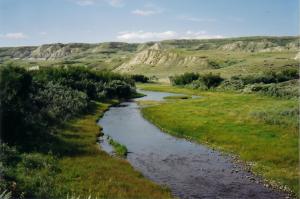
(49°00’ 107°18’; Map sheet 72 G/3). The Frenchman River rises in Cypress Lake and is fed by streams flowing off the southern flank of the Cypress Hills. It flows eastward across southwestern Saskatchewan before turning south across the 49th parallel and into the Milk River in northern Montana. Approximately 341 km long, it is one of the few Saskatchewan rivers that lie within the Mississipi drainage basin. Christiansen and Sauer (1988) have shown that the valley originated as glacial meltwater channel, draining water from an ice-lobe that flowed around the southern edge of the Cypress Hills. Meltwaters carved a channel up to 180 metres deep between the ice and the unglaciated uplands. The modern valley ranges from 30 to 106 metres deep, much of it infilled by debris from ancient landslides.
The Frenchman flows through the West Block of the Grasslands National Park. Its flow is highly variable, and early ranchers trapped floodwaters for irrigation. After the Depression, the PFRA developed irrigation reservoirs at Eastend and Val Marie. The origin of the name is uncertain but both Métis and francophone settlers occupied the region in the early 1900s. The Frenchman River is known locally as the Whitemud River, after the white clays common to the area. The region is immortalized in Wallace Stegner’s Wolf Willow.
Marilyn Lewry